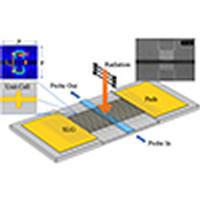当前位置:
X-MOL 学术
›
J. Opt. Soc. Amer. B
›
论文详情
Our official English website, www.x-mol.net, welcomes your
feedback! (Note: you will need to create a separate account there.)
Graphene-incorporated plasmo-thermomechanical infrared radiation detection
Journal of the Optical Society of America B ( IF 1.8 ) Pub Date : 2020-02-19 , DOI: 10.1364/josab.379154 Mohammad Wahiduzzaman Khan , Qiancheng Zhao , Parinaz Sadri-Moshkenani , Md Shafiqul Islam , Ozdal Boyraz
Journal of the Optical Society of America B ( IF 1.8 ) Pub Date : 2020-02-19 , DOI: 10.1364/josab.379154 Mohammad Wahiduzzaman Khan , Qiancheng Zhao , Parinaz Sadri-Moshkenani , Md Shafiqul Islam , Ozdal Boyraz

|
Metallic nanostructures can be used to selectively absorb a specific regime of the infrared (IR) spectrum depending on its constituent materials and geometry. In this paper, we propose and analyze a plasmo-thermomechanical detector that includes a graphene layer on top of metallic nanowires to enhance the absorption and sensitivity. The proposed device converts the free-space IR radiation to mechanical deformation of nanowires that modulates the insertion loss of the waveguide underneath the nanowires and facilitates the on-chip optical readout of the free-space radiation at room temperature. Our design takes advantage of localized surface plasmon resonances to maximize absorption at the desired IR spectrum. We provide a systematic investigation of different material combinations with and without graphene in addition to variations in detector geometry to optimize the designed IR detector. On top of the absorption enhancement, the graphene layer over the nanowires boosts thermal relaxation speed of the nanowires by 3 times due to graphene’s high thermal conductivity, in turn speeding up the response of the IR detection. Moreover, the coated graphene layer enhances the mechanical deformation by a factor of 6 and bends the suspended nanowires downward, enhancing the light–matter interaction between the nanowires and the waveguide evanescent field. Overall, incorporating graphene is beneficial for enhanced spectrum absorption, speed of the IR detection, and optical readout sensitivity.
中文翻译:

石墨烯结合的等离子体热机械红外辐射检测
根据其组成材料和几何形状,金属纳米结构可用于选择性吸收特定的红外(IR)光谱方案。在本文中,我们提出并分析了一种等离子体热机械检测器,该检测器在金属纳米线的顶部包括一个石墨烯层,以增强吸收和灵敏度。所提出的装置将自由空间的IR辐射转换为纳米线的机械变形,从而调节纳米线下方的波导的插入损耗,并促进室温下自由空间辐射的片上光学读取。我们的设计利用局部表面等离振子共振的优势,以最大程度地吸收所需的红外光谱。除了检测器几何形状的变化以外,我们还提供了对使用和不使用石墨烯的不同材料组合的系统研究,以优化设计的红外检测器。除了吸收增强之外,由于石墨烯的高导热性,纳米线上的石墨烯层将纳米线的热弛豫速度提高了3倍,从而加快了IR检测的响应速度。此外,涂覆的石墨烯层将机械变形提高了6倍,并使悬浮的纳米线向下弯曲,从而增强了纳米线与波导渐逝场之间的光-质相互作用。总的来说,掺入石墨烯有利于增强光谱吸收,IR检测速度和光学读出灵敏度。除了吸收增强之外,由于石墨烯的高导热性,纳米线上的石墨烯层将纳米线的热弛豫速度提高了3倍,从而加快了IR检测的响应速度。此外,涂覆的石墨烯层将机械变形提高了6倍,并使悬浮的纳米线向下弯曲,从而增强了纳米线与波导渐逝场之间的光-质相互作用。总的来说,掺入石墨烯有利于增强光谱吸收,IR检测速度和光学读出灵敏度。除了吸收增强之外,由于石墨烯的高导热性,纳米线上的石墨烯层将纳米线的热弛豫速度提高了3倍,从而加快了IR检测的响应速度。此外,涂覆的石墨烯层将机械变形提高了6倍,并使悬浮的纳米线向下弯曲,从而增强了纳米线与波导渐逝场之间的光-质相互作用。总体而言,掺入石墨烯有利于增强光谱吸收,IR检测速度和光学读出灵敏度。涂覆的石墨烯层将机械变形提高了6倍,并使悬浮的纳米线向下弯曲,从而增强了纳米线与波导e逝场之间的光-质相互作用。总的来说,掺入石墨烯有利于增强光谱吸收,IR检测速度和光学读出灵敏度。涂覆的石墨烯层将机械变形提高了6倍,并使悬浮的纳米线向下弯曲,从而增强了纳米线与波导e逝场之间的光-质相互作用。总体而言,掺入石墨烯有利于增强光谱吸收,IR检测速度和光学读出灵敏度。
更新日期:2020-03-02
中文翻译:

石墨烯结合的等离子体热机械红外辐射检测
根据其组成材料和几何形状,金属纳米结构可用于选择性吸收特定的红外(IR)光谱方案。在本文中,我们提出并分析了一种等离子体热机械检测器,该检测器在金属纳米线的顶部包括一个石墨烯层,以增强吸收和灵敏度。所提出的装置将自由空间的IR辐射转换为纳米线的机械变形,从而调节纳米线下方的波导的插入损耗,并促进室温下自由空间辐射的片上光学读取。我们的设计利用局部表面等离振子共振的优势,以最大程度地吸收所需的红外光谱。除了检测器几何形状的变化以外,我们还提供了对使用和不使用石墨烯的不同材料组合的系统研究,以优化设计的红外检测器。除了吸收增强之外,由于石墨烯的高导热性,纳米线上的石墨烯层将纳米线的热弛豫速度提高了3倍,从而加快了IR检测的响应速度。此外,涂覆的石墨烯层将机械变形提高了6倍,并使悬浮的纳米线向下弯曲,从而增强了纳米线与波导渐逝场之间的光-质相互作用。总的来说,掺入石墨烯有利于增强光谱吸收,IR检测速度和光学读出灵敏度。除了吸收增强之外,由于石墨烯的高导热性,纳米线上的石墨烯层将纳米线的热弛豫速度提高了3倍,从而加快了IR检测的响应速度。此外,涂覆的石墨烯层将机械变形提高了6倍,并使悬浮的纳米线向下弯曲,从而增强了纳米线与波导渐逝场之间的光-质相互作用。总的来说,掺入石墨烯有利于增强光谱吸收,IR检测速度和光学读出灵敏度。除了吸收增强之外,由于石墨烯的高导热性,纳米线上的石墨烯层将纳米线的热弛豫速度提高了3倍,从而加快了IR检测的响应速度。此外,涂覆的石墨烯层将机械变形提高了6倍,并使悬浮的纳米线向下弯曲,从而增强了纳米线与波导渐逝场之间的光-质相互作用。总体而言,掺入石墨烯有利于增强光谱吸收,IR检测速度和光学读出灵敏度。涂覆的石墨烯层将机械变形提高了6倍,并使悬浮的纳米线向下弯曲,从而增强了纳米线与波导e逝场之间的光-质相互作用。总的来说,掺入石墨烯有利于增强光谱吸收,IR检测速度和光学读出灵敏度。涂覆的石墨烯层将机械变形提高了6倍,并使悬浮的纳米线向下弯曲,从而增强了纳米线与波导e逝场之间的光-质相互作用。总体而言,掺入石墨烯有利于增强光谱吸收,IR检测速度和光学读出灵敏度。











































 京公网安备 11010802027423号
京公网安备 11010802027423号